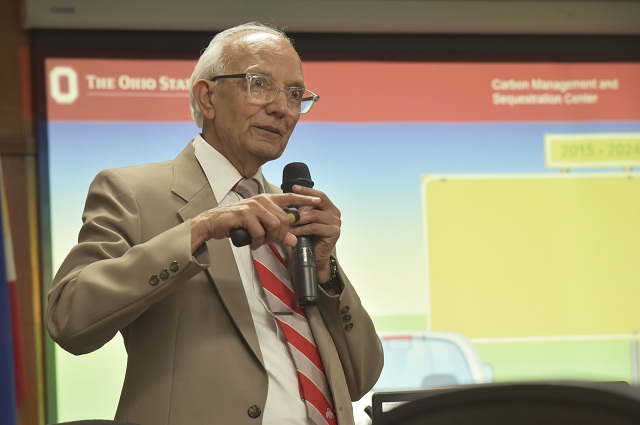Soil degradation is a quiet crisis; it exists but it is barely noticed as it happens slowly. With the current population of the world, which is about 7.3 billion and may reach up to 11 billion by 2050, the more frequent utilization of soil for food production is seen to degrade soil quality.
According to Dr. Rattan Lal, soil scientist from Carbon Management and Sequestration Center, Ohio State University, soil is prone to degradation by natural factors through the effects of climate change and man-made factors such as land misuse and soil mismanagement. One way of addressing this problem is producing more from less.
“Sustainable intensification, it is a strategy to produce more from less by reducing losses and increasing soil, water, and nutrient use efficiency. The key is to produce more food from less land, per drop of water, per unit input of fertilizers and pesticides, per unit of energy, and per unit of Carbon emission,” Lal said during his recent visit at PhilRice Central Experiment Station in Nueva Ecija.
He cited some technological innovations for researchers and policy-makers to follow and promote until 2050 such as soil-less agriculture, precision farming, soil restoration, nutrition-sensitive agriculture, urban/sky farming, and space farming.
Sustainable Soil Management
Living or healthy soil has 5 t/ha of living organism. Putting pesticides and fertilizers, irrigating, and plowing can cause these organisms to die.
“Soil requires balance sheet. Taking things out and not putting anything back depletes soil and its resources,” he emphasized.
Lal cited that a city with more than 10 million people requires 6000 t of food a day. The nutrients used to produce these food will never come back to where it is from.
To effectively manage soils, he noted that people must be obliged to replace what is removed, response wisely to what is changed, predict the effects of natural and anthropogenic factors, and enhance soil resilience.
“I think one way to protect soil is to produce the food we consume within the city, at least 20-25% of it. We have to produce within the urban ecosystem using recycled nutrients and water,” he stressed.
He reminded plant breeders, soil scientists and crop physiologists to work together to address the issue of soil health. He also clarified that no system is universally applicable and that no country follows the best practices. However, he highlighted the presence of good farmers in every country.
“Local extension workers must work with the farming community to identify what is the best option to manage soil properly,” Lal suggested.
Increasing Yield
To produce more crops, he suggested the use of soil organic carbon (SOC) through sequestration, a process of increasing the amount of carbon stored in soil and vegetation. SOC serves as soil fertility basis. It releases nutrients for plant growth, promotes the structure, biological, and physical health of soil, and serves as buffer against harmful substances.
Based on the study he conducted, adding a ton of carbon per hectare in the root zone of the crop can potentially increase yield up to 100-300 kg/ha for corn; 30-60 kg, wheat; and 20-70 kg, rice.
“If all developing countries will add one ton of carbon in the root zone, it will produce an additional 30-50 million tons of better-quality food,” he said.
He also urged young scientist to think of innovative technologies that contribute in maintaining soil quality.
“I encourage you to study micronutrients, phosphorus, and some cover crops. Just make sure that results will go even beyond your laboratory,” he said.





